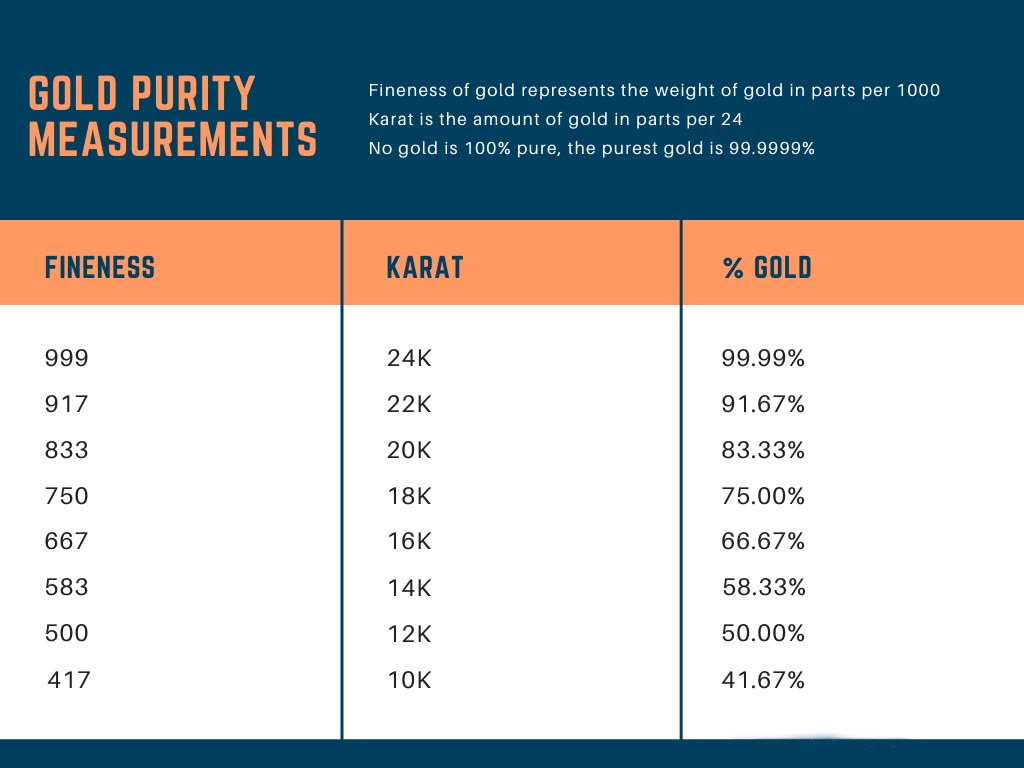Levels of Gold Purity:
For millennia, gold has been valued as a prestige and financial symbol. Its purity—the proportion of pure gold in a piece of jewelry, coin, or bar—determines its value. Because it affects the quality, durability, and price of gold, it is essential for both buyers and sellers to understand the various levels of purity. The idea of gold purity is examined in this article, along with a comprehensive gold purity chart to help you make informed purchases.
What is the purity of gold?
The quantity of pure gold combined with other metals to create an alloy is known as gold purity. Because pure gold, sometimes referred to as 24-karat (24K) gold, is pliable and soft, it cannot be used to create jewelry or other long-lasting objects.
Gold is frequently combined with other metals like copper, silver, zinc, or nickel to increase its strength and endurance.
Gold purity can be stated as a percentage or in karats (K). For instance, 75% of 18K gold is pure gold, with the remaining 25% being made up of other metals. From investment-grade gold to daily jewelry, this harmony between endurance and purity is crucial for a variety of uses.

Purity Levels and Their Applications
24K Gold (99.9% Pure): The purest form of gold, 24K gold boasts a bright yellow hue and a soft texture, making it ideal for investment in gold bars and coins. It is also used in cultural items like gold foil and ornaments. However, its softness makes it unsuitable for jewelry as it is prone to scratches and dents.
22K Gold (91.6% Pure): 22K gold contains 91.6% pure gold and a small percentage of alloyed metals, which add strength and durability. It is commonly used in high-quality jewelry, especially in regions like India and the Middle East, where its rich color and traditional appeal are highly valued. However, it is less durable than lower karat gold, making it more prone to wear and tear over time.
18K Gold (75% Pure): 18K gold strikes a balance between purity and durability, containing 75% pure gold and 25% alloy metals. Its rich color and relative strength make it a popular choice for fine jewelry, including rings, bracelets, and earrings. Although slightly more expensive than 14K gold, its enhanced durability and luxurious appearance justify the cost for those seeking high-quality pieces.
14K Gold (58.3% Pure); 14K gold is favored for its practicality, blending affordability with durability. With 58.3% pure gold, it is commonly used in everyday jewelry such as necklaces, rings, and bracelets. Its robust nature makes it resistant to scratches and dents, making it ideal for those seeking long-lasting wear. However, it is less pure than higher karat gold, which may affect its color and value.
10K Gold (41.7% Pure): 10K gold contains 41.7% pure gold, with a significant proportion of alloy metals. This composition makes it one of the most durable and budget-friendly options for jewelry. Its resistance to scratches and dents makes it suitable for daily wear. However, its lower gold content gives it a duller color compared to higher karat options, which may not appeal to those seeking a more vibrant hue.
9K Gold (37.5% Pure); 9K gold represents the minimum standard for gold in some countries, with 37.5% pure gold. It is primarily used in affordable jewelry, offering a cost-effective alternative for buyers. Despite its low gold content, it is durable and suitable for casual wear. However, its significantly reduced gold percentage means it lacks the richness and value of higher karat gold.
-
Assaying Gold: What it is, How it Works, and Why it Matters According to historical data, gold has proven to…
-
Why you should buy Gold from Africa and with us? Why you should buy Gold from Africa and with us?…
-
Copper cathodes Copper cathodes are used as a raw material feed for the production of high-purity copper and copper alloy products.…
-
In order to achieve social, environmental, and economic advantages for communities worldwide, we are dedicated to collaborating with our stakeholders.…
